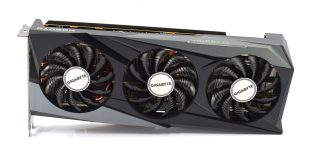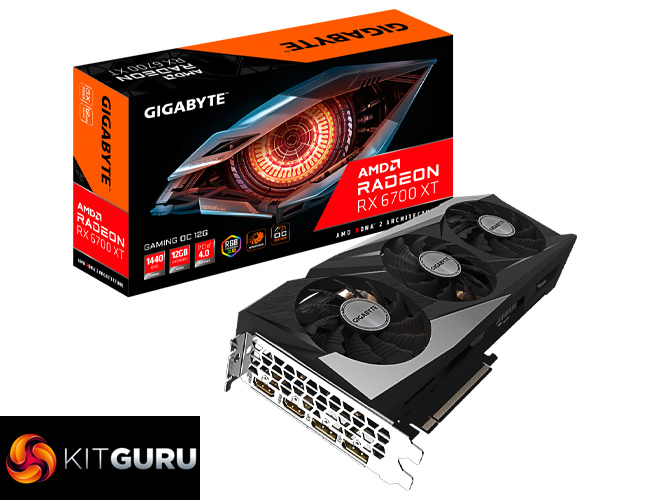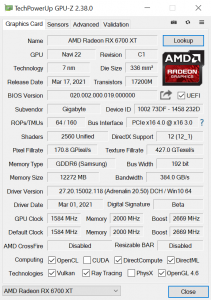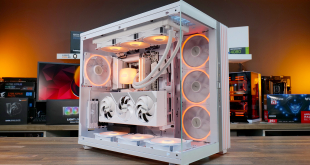
Today we are back with our third RX 6700 XT review, following on from Sapphire's Nitro+ card and AMD's reference design. The card in question is Gigabyte's RX 6700 XT Gaming OC, featuring the company's Windforce 3X cooler, a factory overclocked core and a full-length metal backplate. Is this a 6700 XT to consider, or are there better options?
We've reviewed several of Gigabyte's current-generation graphics cards, including the RX 6900 XT, RTX 3070 and RTX 3060 models. All share the same overall appearance, with just a few differences on show when looking at the internal heatsink design. That applies to the RX 6700 XT Gaming OC as well, though one thing to note right away is that it doesn't support dual-BIOS, which is something found on the RTX 3070 and RX 6900 XT models.
| RX 6900 XT | RX 6800 XT | RX 6800 | RX 6700 XT | RX 5700 XT | |
| Architecture | RDNA 2 | RDNA 2 | RDNA 2 | RDNA 2 | RDNA |
| Manufacturing Process | 7nm | 7nm | 7nm | 7nm | 7nm |
| Transistor Count | 26.8 billion | 26.8 billion | 26.8 billion | 17.2 billion | 10.3 billion |
| Die Size | 519 mm² | 519 mm² | 519 mm² | 336 mm² | 251 mm² |
| Ray Accelerators | 80 | 72 | 60 | 40 | n/a |
| Compute Units | 80 | 72 | 60 | 40 | 40 |
| Stream Processors | 5120 | 4608 | 3840 | 2560 | 2560 |
| Game GPU Clock | Up to 2015MHz | Up to 2015MHz | Up to 1815MHz | Up to 2424MHz | Up to 1755MHz |
| Boost GPU Clock | Up to 2250MHz | Up to 2250MHz | Up to 2105MHz | Up to 2581MHz | Up to 1905MHz |
| Peak SP Performance | Up to 23.04 TFLOPS | Up to 20.74 TFLOPS | Up to 16.17 TFLOPS | Up to 13.21 TFLOPS | Up to 9.75 TFLOPS |
| Peak Half Precision Performance | Up to 46.08 TFLOPS | Up to 41.47 TFLOPS | Up to 32.33 TFLOPS | Up to 26.43 TFLOPS | Up to 19.5 TFLOPS |
| Peak Texture Fill-Rate | Up to 720 GT/s | Up to 648.0 GT/s | Up to 505.2 GT/s | Up to 413.0 GT/s | Up to 304.8 GT/s |
| ROPs | 128 | 128 | 96 | 64 | 64 |
| Peak Pixel Fill-Rate | Up to 288.0 GP/s | Up to 288.0 GP/s | Up to 202.1 GP/s | Up to 165.2 GP/s | Up to 121.9 GP/s |
| AMD Infinity Cache | 128MB | 128MB | 128MB | 96MB | n/a |
| Memory | 16GB GDDR6 | 16GB GDDR6 | 16GB GDDR6 | 12GB GDDR6 | 8GB GDDR6 |
| Memory Bandwidth | 512 GB/s | 512 GB/s | 512 GB/s | 384 GB/s | 448 GB/s |
| Memory Interface | 256-bit | 256-bit | 256-bit | 192-bit | 256-bit |
| Board Power | 300W | 300W | 250W | 230W | 225W |
RX 6700 XT is built using the Navi 22 GPU, a physically smaller die than Navi 21, measuring 336 mm². It houses 40 Compute Units (CUs), with 64 stream processors per CU, giving a total of 2560. RX 6700 XT features a fully populated Navi 22 GPU, but we can expect cut-down versions to appear with the RX 6700, and potentially RX 6600 XT if that comes to market.
RDNA 2 houses one ray accelerator per CU, so there's a total of 40 with the RX 6700 XT. Four texture units per CU gives a total of 160, while there's also 64 ROPs. The reference 6700 XT has a rated game clock of 2424MHz, but Gigabyte has increased this to 2514MHz.
As for the memory configuration, AMD has opted to use a 192-bit memory interface paired with 12GB of GDDR6 memory. Using 16Gbps modules, total memory bandwidth hits 384 GB/s, which is lower than its predecessor, the RX 5700 XT. RDNA 2 GPUs, however, have the benefit of AMD's Infinity Cache, with a 96MB cache used here.
Lastly, reference total board power (TBP) is rated at 230W. Gigabyte hasn't confirmed that the TBP has increased with the Gaming OC, but we would expect that to be the case. This is something we test later in the review.
 KitGuru KitGuru.net – Tech News | Hardware News | Hardware Reviews | IOS | Mobile | Gaming | Graphics Cards
KitGuru KitGuru.net – Tech News | Hardware News | Hardware Reviews | IOS | Mobile | Gaming | Graphics Cards




